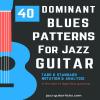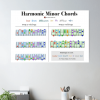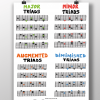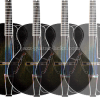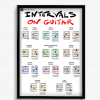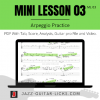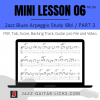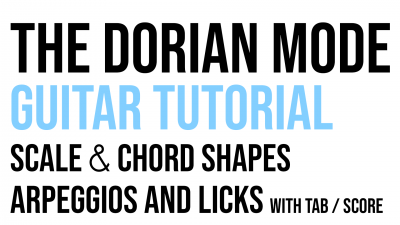
Melodic Minor Scale Exercises For Guitar – Position Shifts
- By jazz-guitar-licks
- On 2018-01-14
- In Scales & Arpeggios
- 0 comments
Learning and playing scales can be an important part of any guitarist’s practise regime.
By playing scales in a variety of ways we can develop our familiarity with the fretboard beyond simply going up and down scales.
In this tutorial we will look at combining two different scale patterns by shifting between them on various strings.
For this we are going to use two patterns of an Eb Melodic minor scale, patterns 2 and 3.
The Melodic minor scale consists of the intervals R 2 b3 4 5 6 7 (R is for the Root note).
Melodic minor scale guitar patterns (Eb)
The different shades of light and dark in the scale diagrams show separate occurrences of what is actually the same seven intervals of the Eb Melodic minor scale, repeated across different octaves.
This is not for beginners I’m afraid so if you are not already familiar with these scales and how to play them then you’ll need to familiarize yourself before moving on.
Both the above patterns have been shown in their relative places to each other on the fretboard, reflecting how Eb Melodic minor pattern 3 is further up from Eb Melodic minor pattern 2.
Notice how most of the intervals on the 8th and 9th frets are in the same locations for both patterns.
These are the points at which we will transition between the two patterns.
We will start with shifting on the A string, followed by the D string, the G and finally the B string.

Shifting between the patterns on the A string
In the below guitar tab, some italic numbers have been added underneath to show which fretting hand fingers to use for the above notes; 1 = index finger, 2 = middle finger, 3 = ring finger and 4 = little finger.
These show the ways in which the fretting hand can deal with the shifts, both on the way up and on the way down, so if you are ever unsure where the shifts are, just look for the italic numbers underneath.
Melodic minor scale guitar pattern

The two rows of italic numbers under the first bar show two different ways of approaching the position shift during the ascent.
The first (1 2 1 2 4) relies on the 1st finger jumping up to the 8th fret.
The second, just below (1 2 4 2 4) relies on the 2nd finger jumping up to the 9th fret.
In both cases the hand position moves upward by three frets.
For the descent on the fourth to fifth bars (4 2 1 2 1), the 2nd finger jumps down to the 6th fret.
The reason only one version is shown for the descent is because the other option would be for the 4th finger to jump down to the 8th fret (just after the 2nd finger has played the 9th fret).
Not impossible but not as practical as the former.

For the ascent on bars one to two the first approach (1 3 2 4) relies on the 2nd finger jumping up to the 10th fret.
The second approach just below (1 1 2 4) is not as efficient as it relies on the same finger playing different consecutive notes with a jump up from the 6th fret to the 8th fret by the 1st finger.
Given the choice I would opt for the first approach. You may prefer the second, as it can be subjective to a player’s particular technique.
For the descent on bar four, the first approach (4 2 3 1) relies on the 3rd finger jumping down to the 8th fret.
The second approach just below (4 2 1 1) relies on the 1st finger playing consecutive notes as it moves from the 8th fret to the 6th fret.

For the ascent on bar two the first approach (1 3 1 3 4) relies on the 1st finger jumping up to the 8th fret.
The second approach just below (1 3 4 3 4) relies on the 3rd finger jumping up to the 10th fret.
For the descent on bars three to four (4 3 1 3 1) the 3rd finger jumps down to the 7th fret.
This, I find, is pretty much the best way of shifting on the descent, therefore the only approach shown for it.

For the ascent on bar two (1 2 2 4) the 2nd finger jumps up to the 9th fret straight after having played the 7th fret.
The second approach just below (1 1 2 4) relies on the 1st finger jumping up to the 7th fret after having played the 6th fret.
For the descent on bar three (4 2 2 1) the 2nd finger jumps down to the 7th fret straight after having playing the 9th fret.
The second approach just below (4 2 1 1) relies on the 1st finger jumping down to the 6th fret from the 7th fret.
For all instances of shifting on the B string whether ascending or descending, you may have noticed the same finger is being used to play different consecutive notes.
Those four exercises can make a good hours practise session with a metronome.
The position shifts could also be treated as their own separate exercises for moving across a single string.
Below is an example of the first approach from earlier for going up and down while shifting across the A string.
Melodic minor scale guitar pattern

Conclusion
The principle of shifting between patterns can apply to any scale, for any pattern, anywhere on the fretboard, whether that’s a relatively simple Major scale between patterns 1 to 2, or say, a more advanced Locrian Natural 2 scale (the mode off the 6th of the melodic minor) between scale patterns 4 and 5.
You will come across different technical challenges depending on what scales and patterns you use and which string you shift on.
Shifting patterns makes for a good technical coordination exercise but is also good for developing fret-board familiarity beyond staying within one CAGED scale shape. Don’t forget to use a metronome when you practise!
About the author
Gareth Evans is a musician, teacher and writer with interests in electric guitar, classical guitar and bass.
Check out his Guitar Website for more guitar tips and to learn more about his work.
-
Guitar Scale Dictionary
This E-book is a printable PDF method including over 700 scale diagrams and formula charts for guitarists. -
Guitar Chord Dictionary
This PDF eBook provides over 550 guitar chord shapes. This is the perfect reference guide to understand how chords are built and how to play them on the guitar neck. -
30 Groovy Jazz Guitar Licks
This downloadable package contains a PDF WITH audio files giving access to 30 groovy guitar phrases mixing jazz, blues and funky licks for beginners. -
172 Arpeggio Shapes For Guitar
This printable PDF is a method dedicated to guitarists of all styles who want to learn build and play the most important types of arpeggios. -
126 Triad Chord Shapes
This handbook for guitar players is intended both for teachers and students. It includes 126 guitar shapes for mastering triads. -
Harmonic Major Scale Chords
this PDF offers diagrams and tabs for guitar to learn the chords of the harmonic major scale. -
Major Scale Harmonization
This package provides a printable PDF with exercises and audio files to learn how to harmonize the major scale with 3 note chords and their extensions. -
30 Minor Arpeggio Licks
This package includes a printable PDF method containing 30 exercises with tabs, staves and audio files for practicing minor arpeggios on guitar. -
II V I Bundle - 170 Exercises
This bundle contains 4 PDF methods for a total of 170 exercises with tabs, staves, analysis & audio files for practicing scales, arpeggios licks & chords over the 2-5-1 progression. -
Diatonic Licks Bundle
This package contains 120 jazz guitar lines based on diatonic modes as Mixolydian, Dorian and Ionian. PDF format with tabs, audio files and analysis. -
30 Smooth Jazz Guitar Licks
In this package you'll get a printable PDF Method with tabs, notation, analysis, scale shapes and audio files for practicing 30 smooth jazz guitar licks. -
40 II V I Jazz Guitar Licks
This pdf method for guitar contains fourteen 2 5 1 jazz guitar lines with tab, standard notation, analysis, scale charts and audio files. -
50 II-V-I voicings
This printable PDF guitar method provides 50 exercises with audio files, analysis, tab and staves for learning major 2-5-1 chord voicings. -
40 Minor 2 5 1 Chord Voicings
This PDF method contains 40 exercices with tabs, scores and audio files for practicing jazz guitar chords over the minor 2 5 1 progression. -
40 Minor II V I Licks
This guitar method is a printable PDF with tabs, diagrams, theory and audio files providing 40 minor 2 5 1 jazz patterns. -
40 Mixolydian Jazz Guitar Lick
PDF guitar method with tabs, audio files and theory providing 40 dominant jazz guitar lines for teachers and students. -
40 Minor Jazz Guitar Licks
This printable guitar method in PDF format contains 40 easy minor jazz guitar lines based on the Dorian mode. -
40 Major Jazz Guitar Licks
Printable PDF eBook method containing 40 major jazz guitar licks with tab, standard notation and audio files for beginners and intermediates. -
Guitar Walking Bass Lines
This jazz guitar method about walking bass lines and chords is available as a PDF files containing 35 exercises with tabs, analysis and audio files -
101 Dominant Arpeggio Patterns
This printable PDF method provides 101 dominant arpeggio exercises with tab, theory and standard notation for the jazz, blues and rock guitarist. -
49 Essential Jazz Lines
This printable eBook method in PDF format provides 49 jazz solo transcriptions of the greatest jazz musicians. Tab, standard notation, audio files & analysis. -
11 Jazz Blues Studies
11 jazz blues chord studies with tabs, standard notation, analysis, and audio recordings and PDF. -
10 Easy Fingerstyle Blues
This PDF with Tabs and audio files provides 10 easy acoustic fingerstyle blues guitar studies for kids and beginners. -
25 Altered Jazz Guitar Lines
This PDF eBook method contains 25 altered jazz guitar licks with tabs, patterns, scale charts and audio files to master, apply and develop the altered scale. -
40 Blues Dominant Patterns
This printable method is available as a PDF file containing 40 easy dominant jazz-blues guitar lines with tabs, standard notation, analysis, audio files and scale charts. -
25 Pentatonic Licks
This jazz guitar method is an eBook available as a PDF with standard notation, guitar tabs, diagrams, analysis, audio files and backing tracks. You will find in this booklet 25 easy jazz guitar lines with theory using common and rare pentatonic scales. -
25 Soul Jazz Guitar Licks
You will find here an eBook available in PDF containing 25 soul jazz and hard bop guitar licks in the style of Grant Green, Melvin Sparks, George Benson. -
25 Diminished Patterns
This eBook PDF with audio files contains 25 dominant diminished jazz guitar patterns using the half-whole diminished scale and diminished 7th arpeggios. -
6 Tritone substitution licks
This Printable PDF eBook available for free download contains 6 easy jazz guitar licks with tabs/notation, youtube video link and analysis about the tritone substitution. -
10 Minor 7 Arpeggio Patterns
This printable PDF eBook offers 10 easy minor 7 arpeggio patterns with its related YouTube video for beginner guitarists. -
10 Easy Major 7 Arpeggio Licks
This is a printable PDF for beginner jazz guitar players providing 10 easy licks to practice major 7 arpeggios. -
10 Chord Melody Lines
Within this package, you'll discover a set of ten chord melody exercises for beginners. Printable PDFaudio files, a backing track, and a link to the associated YouTube video. -
10 Minor Blues Scale Licks
You'll find here a PDF with 10 easy jazz guitar licks to practice the minor blues scale on guitar.
-
Major Scale Modes
This poster is created for music teachers and students, illustrating the structure of the seven modes of the major scale. -
Harmonic Minor Modes
This music theory poster, offered in various sizes, demonstrates the structure of the seven modes of the melodic minor scale. -
Melodic Minor Modes
This music theory poster available in several sizes shows the construction of the seven modes of the melodic minor scale. -
Major Scale Chords
This handy poster provides a clear visual guide to the chords built from the major scale, helping you recognize patterns and improve your playing. -
Melodic Minor Chords
Explore the rich harmonic possibilities of the melodic minor scale with this essential guitar poster. -
Harmonic Minor Chords
Discover the chords of the harmonic minor scale with this guitar poster. -
Guitar Arpeggios Poster
This giant guitar poster for any guitar player, student or instructor contains colorful arpeggio diagrams. Giant size 24 x 36 inches (60 x 90 cm). -
Guitar Scales Poster 24*36
Guitar posters and wall art with eighteen neck diagrams representing the most used scales in music. -
Guitar Chord Poster
This printed color posters contains 63 guitar chord diagrams for jazz players, students, teachers and schools. -
Guitar Modes Poster
Guitar reference posters and wall art about modes of the major scale for guitar teachers, students and music schools. -
Melodic Minor Modes Poster
Educative and decorative giant guitar poster with neck diagrams, interval names about the seven modes of the melodic minor scale. -
Pentatonic Scale Guitar Poster
This guitar reference poster shows the positions and intervals of the major pentatonic scale. -
Guitar Notes Poster
This is a giant poster showing the notes on the guitar fret board and their positions on a musical staff. -
Triads Guitar Poster
This reference poster show the positions and intervals of the main triads used on guitar. This is a useful tool for guitarists, teacher and students. -
Four Archtop Guitars Poster
This is a decorative poster with four archtop jazz guitars. Several size and colors in landscape format available on Teespring and redbubble. -
Intervals On Guitar - Poster
This giant poster for guitar provides neck diagrams with interval positions.
-
Mini Lesson 01 (ML 01)
You'll find a mini guitar lesson about walking bass lines and chords containing a PDF with tab, score analysis, shapes, a video and a guitar pro file. -
Mini Lesson 02 (ML 02)
In this mini jazz guitar lesson you will learn how to play easy and cool jazz lines over basic chord changes found in jazz. Pdf, tab and video included. -
Mini Lesson 03 (ML 03)
With this short lesson you will learn how to play and connect basic guitar arpeggios over a diatonic chord progression. -
Mini Lesson 04 (ML 04)
This is a downloadable package with PDF, Tab, guitar pro file and video to practice guitar arpeggios over a jazz blues chord progression. -
Mini Lesson 05 (ML 05)
This downloadable package provides a PDF with Tab/score, a guitar pro file and a short video for practicing guitar arpeggios on a jazz blues progression in Bb. -
Mini Lesson 06 (ML 06)
This package for guitarists contains a PDF with tab, video, backing track and guitar pro file for practicing arpeggios over a basic jazz blues progression. -
Mini Lesson 07 (ML 07)
With this mini guitar lesson you will learn how to superimpose arpeggios over a diatonic chord progression. Video, pdf, jamtrack and guitar pro file included. -
Mini Lesson 08 (ML08)
Mini lesson with PDF, guitar pro file, video and backing track for practicing scale and arpeggio connections over a Bb jazz blues progression. -
Mini Lesson 09 (ML09)
This mini lesson is a downloadable package containing a PDF, video, backing track and guitar pro file of a jazz blues progression study in B. -
Mini Lesson 10 (ML 10)
This mini guitar lesson provides a printable PDF with tab/notation, video, backing track and guitar pro file for practicing open triads over Fly Me To The Moon. -
Mini Lesson 11 (ML 11)
This guitar lesson is a package inlcuding a PDF transcription with analysis, a short video, a backing track and a guitar pro file to learn to play jazz solo lines over Blue Bossa. -
Jazz Blues Guitar Study (ML12)
This mini lesson provides a video, a guitar pro file and PDF transcription of a jazz blues study in G implying melodic lines, chord extensions and substitutions
guitar scales jazz scale melodic minor scale jazz guitar lesson jazz guitar lessons
Add a comment

























